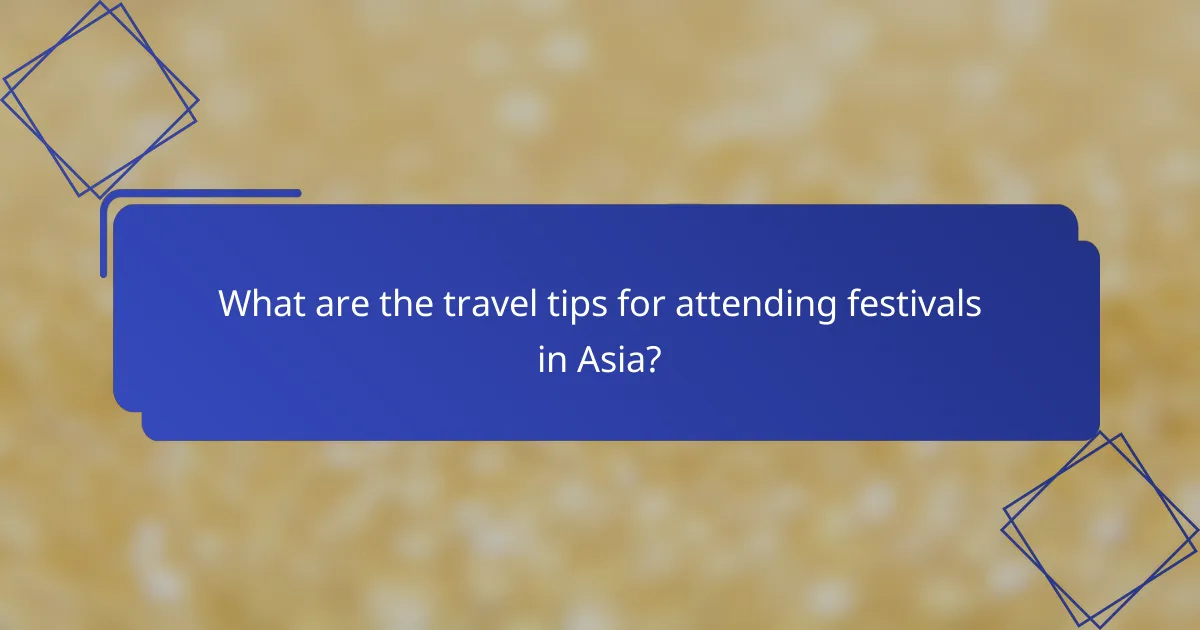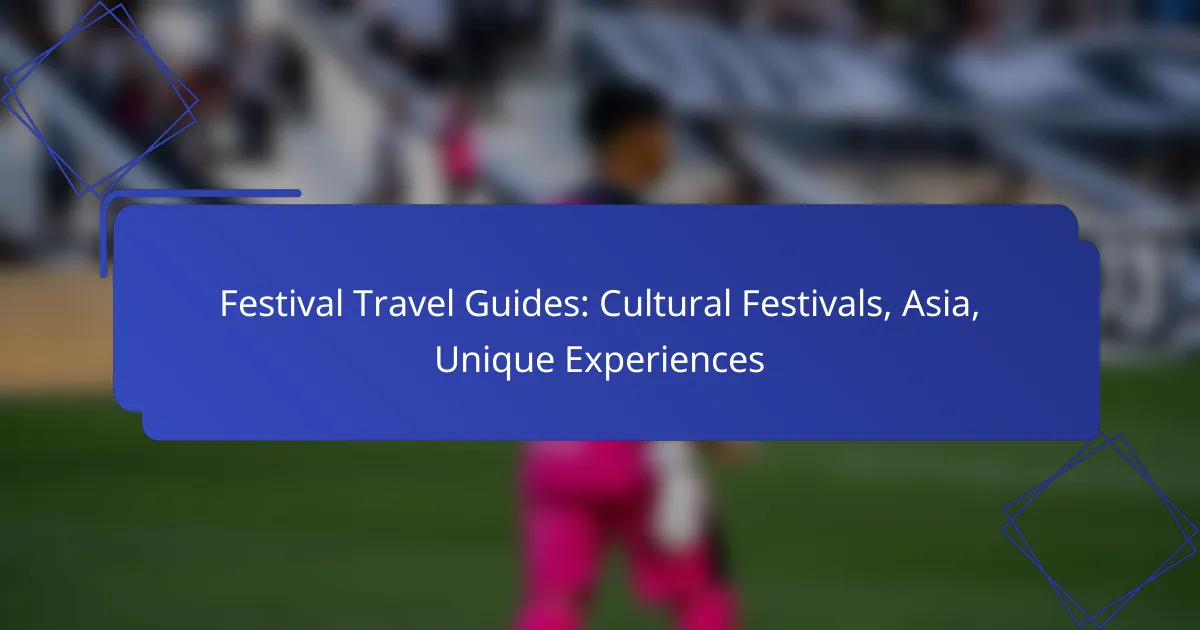Asia is home to a dazzling array of cultural festivals that celebrate its rich traditions and customs, with events like Diwali, Songkran, and Chinese New Year drawing millions of visitors each year. These festivals not only offer unique experiences but also provide travelers with a chance to immerse themselves in local culture, from participating in traditional ceremonies to enjoying regional cuisines. To make the most of your festival travel, it’s essential to plan ahead by considering local customs, securing accommodations early, and staying informed about travel advisories.

What are the top cultural festivals in Asia?
Asia hosts a variety of vibrant cultural festivals that showcase the region’s rich traditions and customs. Notable festivals like Diwali, Songkran, and Chinese New Year attract millions of participants and offer unique experiences for travelers.
Diwali in India
Diwali, known as the Festival of Lights, is celebrated by millions across India and other countries. It typically occurs in October or November and symbolizes the victory of light over darkness and good over evil.
During Diwali, homes are adorned with oil lamps, colorful rangoli designs, and fireworks light up the night sky. Visitors can enjoy traditional sweets, participate in prayers, and witness vibrant street celebrations.
Songkran in Thailand
Songkran, celebrated in mid-April, marks the Thai New Year and is famous for its water festival. The event symbolizes the washing away of sins and bad luck, making it a time for renewal and celebration.
Travelers can join in the fun by participating in water fights, visiting temples, and enjoying traditional Thai food. It’s advisable to wear waterproof clothing and be prepared for a lively atmosphere in cities like Bangkok and Chiang Mai.
Chinese New Year across Asia
Chinese New Year, also known as Lunar New Year, is celebrated by millions in various Asian countries, including China, Vietnam, and Singapore. The festival usually falls between late January and mid-February and lasts for several days.
Festivities include family reunions, dragon dances, and fireworks. Visitors can experience vibrant parades and enjoy traditional dishes like dumplings and rice cakes. It’s a time for honoring ancestors and wishing for prosperity in the coming year.
Holi in India
Holi, the Festival of Colors, is celebrated in March and signifies the arrival of spring. It is a joyous occasion where people throw colored powders and water at each other, symbolizing love and unity.
Travelers can immerse themselves in the festivities by participating in local celebrations, enjoying festive foods, and experiencing the vibrant atmosphere. It’s essential to wear old clothes, as the colors can stain, and to stay hydrated during the celebrations.
Gion Matsuri in Japan
Gion Matsuri, held in July in Kyoto, is one of Japan’s most famous festivals, celebrating the city’s cultural heritage. The festival features elaborate floats, traditional clothing, and various events throughout the month.
Visitors can enjoy the stunning parades, participate in local rituals, and sample traditional Japanese cuisine. It’s advisable to check the festival schedule in advance to catch the main events, especially the grand procession on July 17.

How to plan for festival travel in Asia?
Planning for festival travel in Asia requires careful consideration of local customs, early accommodation bookings, and awareness of travel advisories. These steps ensure a smoother experience and deeper cultural immersion during your visit.
Research local customs and traditions
Understanding local customs and traditions is crucial when attending festivals in Asia. Each country and region has unique practices, rituals, and etiquette that can enhance your experience and help you connect with the local culture.
For example, in Thailand, the Songkran Festival involves water fights and is celebrated with great enthusiasm. Knowing the significance of these traditions can help you participate respectfully and enjoyably.
Book accommodations early
Accommodations can fill up quickly during festival periods, so it’s wise to book your stay well in advance. Popular festivals may see a surge in visitors, leading to higher prices and limited availability.
Consider using platforms like Airbnb or Booking.com to secure a place that fits your budget, whether it’s a hotel, guesthouse, or local homestay. Aim to book at least a few months ahead, especially for major events.
Check travel advisories
Before traveling, check for any travel advisories related to your destination. These advisories can provide essential information about safety, health risks, or local regulations that may affect your trip.
Government websites and reputable travel forums are good sources for the latest updates. Staying informed can help you avoid potential issues and ensure a safe and enjoyable festival experience.

What unique experiences can you have at Asian festivals?
Asian festivals offer a variety of unique experiences that immerse visitors in local culture, traditions, and flavors. From participating in traditional ceremonies to savoring regional cuisines, each festival provides a distinct opportunity to engage with the community and its heritage.
Participating in traditional ceremonies
Engaging in traditional ceremonies at Asian festivals allows visitors to witness and partake in age-old practices that reflect the local culture. These ceremonies often include rituals, dances, and performances that are integral to the festival’s significance.
For example, during the Diwali festival in India, participants can join in the lighting of lamps and the exchange of sweets, symbolizing the victory of light over darkness. Similarly, the Songkran festival in Thailand features water pouring rituals that signify purification and the welcoming of the new year.
Tasting regional cuisines
Asian festivals are a culinary delight, showcasing a wide array of regional cuisines that highlight local ingredients and cooking techniques. Visitors can sample traditional dishes that are often prepared specifically for the festival, offering a taste of the area’s culinary heritage.
At the Chinese New Year celebrations, for instance, dishes like dumplings and fish are served to symbolize prosperity and abundance. In Japan, the cherry blossom festival features seasonal treats such as sakura mochi, a rice cake wrapped in cherry leaves, enhancing the festive experience.
Exploring local arts and crafts
Many Asian festivals feature vibrant displays of local arts and crafts, providing an opportunity for visitors to appreciate and purchase handmade items. These crafts often reflect the cultural identity and traditions of the region.
During the Bali Arts Festival in Indonesia, attendees can explore a variety of traditional crafts, including intricate wood carvings and batik textiles. Festivals like the Gion Matsuri in Japan showcase stunning floats and traditional costumes, allowing visitors to admire the craftsmanship and artistry involved.

What are the best times to visit cultural festivals in Asia?
The best times to visit cultural festivals in Asia vary by season, with each offering unique experiences. Spring, summer, and fall present distinct celebrations that highlight local traditions and customs.
Spring for cherry blossoms in Japan
Spring is the prime season for cherry blossom festivals in Japan, typically occurring from late March to early April. These festivals celebrate the fleeting beauty of sakura, attracting visitors to parks and gardens across the country.
During this time, cities like Tokyo and Kyoto host hanami (flower viewing) parties, where locals and tourists gather under blooming trees. Expect vibrant picnics, traditional performances, and food stalls offering seasonal delicacies.
Summer for outdoor festivals
Summer is bustling with outdoor festivals throughout Asia, often featuring music, dance, and food. Events like the Gion Matsuri in Kyoto or the Lantern Festival in Taiwan take place during this season, typically from June to August.
These festivals often include parades, fireworks, and local crafts. Be prepared for warm weather and large crowds, and consider booking accommodations well in advance to secure your stay.
Fall for harvest celebrations
Fall marks the time for harvest festivals across Asia, celebrating the bounty of crops and local traditions. Festivals like the Mid-Autumn Festival in China and the Tsukimi in Japan occur from September to November.
These events often feature mooncakes, traditional dances, and community gatherings. It’s a great opportunity to experience local culture and cuisine, so try to participate in activities and taste regional specialties during your visit.

What are the travel tips for attending festivals in Asia?
To make the most of your festival experience in Asia, it’s essential to understand local customs, stay healthy, and navigate transportation effectively. These tips will help you immerse yourself in the culture while ensuring a smooth and enjoyable visit.
Dress appropriately for the culture
Understanding the cultural norms of the festival location is crucial when selecting your attire. Many Asian festivals have specific dress codes that reflect local traditions, so research what is appropriate to avoid any faux pas. For example, wearing traditional clothing such as a kimono in Japan or a saree in India can enhance your experience and show respect for the culture.
Additionally, consider the climate and weather conditions during the festival. Lightweight, breathable fabrics are ideal for hot and humid environments, while layers may be necessary in cooler regions. Always prioritize comfort, as you may be walking or standing for extended periods.
Stay hydrated and healthy
Maintaining hydration is vital when attending festivals, especially in warm climates. Carry a reusable water bottle and refill it at designated stations to ensure you stay refreshed throughout the day. In many Asian countries, bottled water is widely available, but be cautious of street vendors and ensure the seal is intact before purchasing.
Be mindful of food safety as well. While street food can be a highlight of the festival experience, choose vendors that appear busy and have a high turnover of food to minimize the risk of foodborne illnesses. If you have dietary restrictions, research local options in advance to avoid any surprises.
Use local transportation options
Utilizing local transportation can enhance your festival experience while allowing you to engage more with the culture. Options such as buses, trains, and tuk-tuks are often affordable and provide a unique perspective of the area. Familiarize yourself with the local transit system before the festival to avoid confusion.
In many cities, rideshare apps are also available and can be a convenient way to get to and from festival venues. However, be aware of peak times when demand may surge, leading to higher fares. Always plan your return trip in advance, especially if the festival lasts late into the night.



